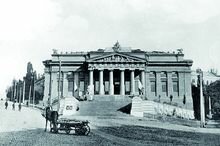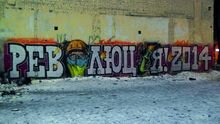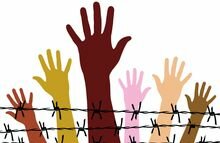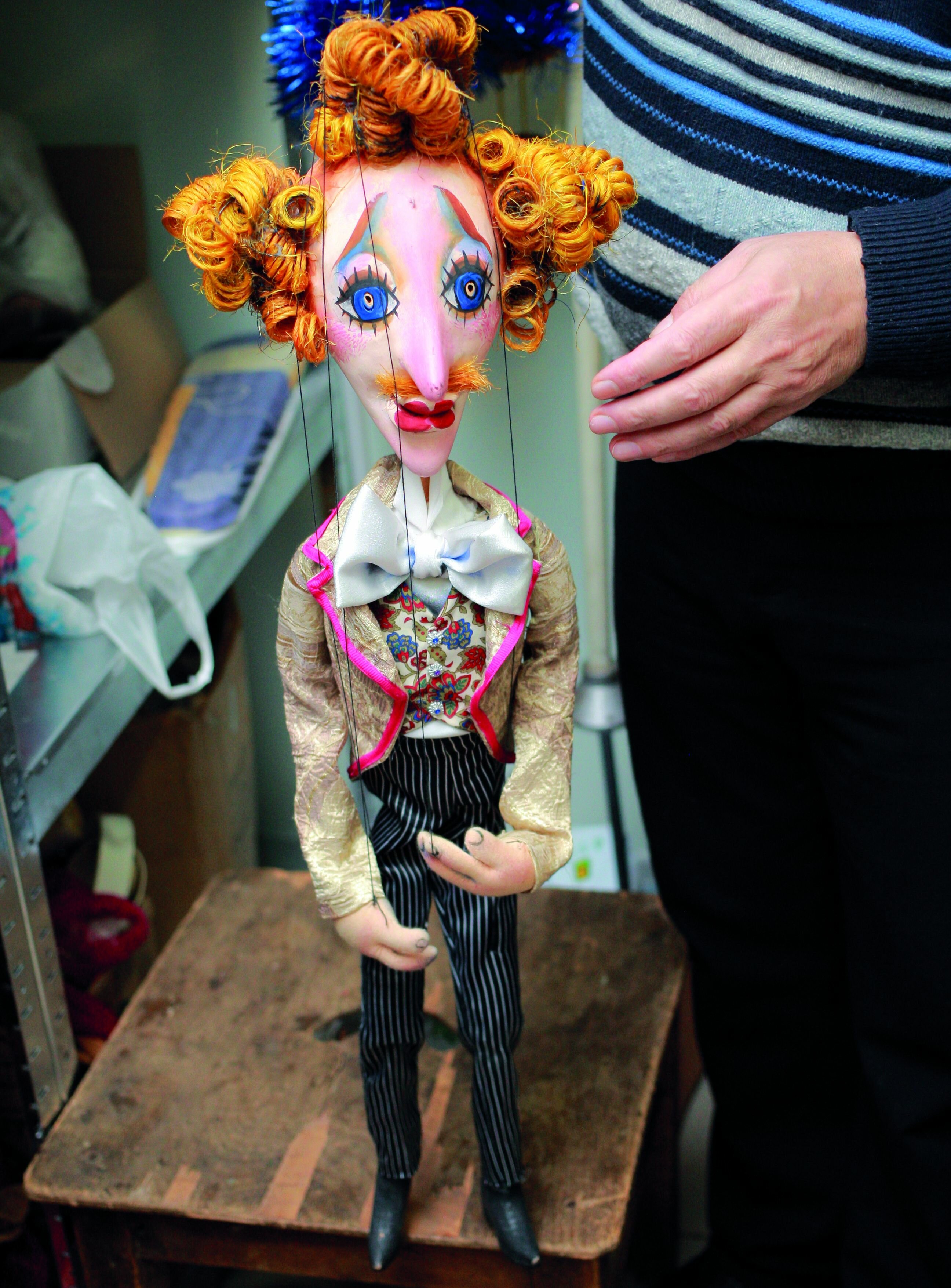| On the cover |
| №7 (2014) |
.jpg) |
Tunnelling Towards Hope
more...
|
| 28 February - 6 March 2014 |
|
| Ukraine History |
|
A Stronghold of Rulers and Rebels

With the recent death toll jumping to nearly 100 and 1,000 injured, Hrushevskoho Street, one of the strongholds of EuroMaidan’s three-month-long protests, made headlines around the globe. It was here, on 19 January the country’s stand against government corruption, abuse of power, and the violation of human rights turned from peaceful protest to all-out revolution. Having witnessed much over the years, Hrushevskoho is a street with a history, and not only care of recent days.
more...
|
| Ukraine Today |
 Acelebrity using their status and intelligence to influence public views and opinion is rarely seen in modern society, even less so in Ukraine. Here, the majority of celebs use their time, effort, and money to enhance or further their career rather than put their name to something that can do good for others. However, as EuroMaidan intensifies, some are making themselves heard – and they fall either side of the EuroMaidan divide.
It used to be that when rebellion and revolution occurred, the intellectual, creative, and spiritual elite would be front and centre.
more...
|
| Ukrainian Culture |
|
When Walls Can Talk

People have been writing on walls since the dawn of civilisation, we call it graffiti, and ranges from simple written words to elaborate wall paintings. Sometimes it is merely the creator wanting to leave his or her mark; sometimes there is an underlying social or political reason. And it is due to the latter that graffiti has exploded across Kyiv in recent months. Anti dictator messages aside, we peel back a few layers of paint to look at graffiti in the city in general.
more...
|
|
| Kyiv Art |
Challenging WWII Taboos
|
|
 Ukraine's World War II experience has always been as controversial as it was tragic, with the country torn between Hitler and Stalin. One of the many subjects that was considered taboo was the plight of the Ostarbeiters, or slave workers forcibly deported to the Third Reich. This week the ever innovative Mystets gallery tries to break the silence with the 'OstRemembrances & WestReality' project showcasing 1940s photos of Ukrainian Ostarbeiter women. The exhibition is something of a departure from the old images of slave labourers in armaments factories and suggests that for some the war years were indeed bearable.
|
|
This week Mystets gallery hosts the 'OstRemembrances & WestReality' exhibition consisting of 20 original photos of Ukrainian Ostarbeiter women made by an unknown German photographer in his studio between the years 1. The Ostarbeiters topic has been forbidden ground throughout the Soviet era and it still isn't a subject you're likely to find openly discussed over a cup of coffee. 'OstRemembrances & WestReality' project reached Mystets gallery via Doctor of Art and member of international art critic association Oleksiy Rogotchenko who came across the topic when writing his thesis on Ukrainian Soviet art of the 1930s. Rogotchenko was actively searching for materials and was a frequent guest at various libraries and flea markets, and five years ago he was offered the photo album of an Ostarbeiter girl from Dnipropetrovsk. Thus the persistent art historian found himself in possession of a collection of 20 black-and-white photos and started investigating the topic. Rogotchenko recorded several hours of interviews with former Ostarbeiters currently living in Poltava and Cherkassy regions. These recordings will now be played non-stop in Mystets gallery to accompany the photo exhibition of the Ostarbeiter girls. "These photos were taken each year in the same studio with other girls from Ukraine also included. This allows us to see them changing from year to year," concludes Rogotchenko. "At first they look like typical Ukrainian village girls and on the later photos they are much more like ordinary cosmopolitan Germans," says the art critic.
The use of vast numbers of foreign workers was planned before Germany went to war and was in itself an integral part of the Nazi conspiracy for waging aggressive war. Although some labour was forcibly recruited in Western Europe the original plans called for mass deportations from the occupied East as a limitless pool of slave labour. On 23 May 1939 a meeting was held in Hitler's study at the Reich’s Chancellery. Hitler stated, "If fate brings us into contact with the West, the possession of extensive areas in the East will be advantageous. We shall be able to rely upon record harvests, even less in time of war than in peace. The population of non-German areas will perform no military service, and will be available as a source of labour". The theory of the ‘master race,’ which underlay the conspirators' labour policy in the East, was perhaps best expressed in the following words by Erich Koch, Reichskommissar for the Ukraine, at a meeting of the National Socialist Party on 5 March 1943 in Kyiv, "We are the master race and must govern hard. I will draw the very last out of this country. I did not come to spread bliss. I have come to help the Fuehrer. The population must work, work, and work again." An estimated one and a half million Ukrainians were forcibly taken to Germany during the 1941-44 occupation as slave workers, but the fates they met there varied enormously. Many were forced to work on armaments projects in abysmal conditions where life expectancy ran to mere weeks, but more fortunate victims ended up as maids or nannies in middle class German homes. Initially there was an effort to recruit willing workers, and a campaign was launched in January 1942 to encourage Ukrainians to volunteer. Posters declaring 'on 28 January the first special train will leave for Germany with hot meals in Kiew, Zdolbunov and Peremyshl' appeared in Kyiv at the turn of the year. The first train was duly full by 22 January. By March the campaign was in full flow with newspapers carrying adverts declaring, 'Germany calls you! Go to beautiful Germany! 100,000 Ukrainians are already working in free Germany. What about you?' However, news had already begun to filter back about the terrible conditions many Ostarbeiter faced in the Third Reich and the pool of volunteers soon dried up. As a result the Germans were forced to resort to mass round-ups, often using the ploy of targeting large gatherings such as church congregations and crowds at sporting events, with entire groups simply marched off at gunpoint to waiting cattle trucks and deported to Germany.
Upon liberation the fate of these prisoners was often little better than that which awaited Soviet prisoners of war who survived years of incarceration in Nazi concentration camps. Stalin took a particularly hard line over the issue of surrendering and had during the war condemned anyone who fell into enemy hands as a traitor. The Soviet dictator even refused an offer to exchange his own son, who was taken prisoner in 1942, for a German general, and upon their return to the Soviet UNI0N many POWs were sent straight to Soviet Gulag camps in Siberia. Although the vast majority of slave workers were spared this fate, they did suffer from state-sanctioned stigmatisation, with special references in their passports (and the passports of children and relatives) mentioning their time in Germany during the war. Many jobs were off-limits to anyone unlucky enough to carry such a status, and during periods of repression former slave labourers would often be ostracised by the wider Soviet community. Many victims have testified that since the war they have suffered a lifetime of abuse and suspicion from their fellow countrymen, many of whom have accused them of being traitors who helped the Germans and lived comfortably in the Third Reich while Ukraine burned. However, Rogotchenko has managed to build up a new perspective based on the numerous materials relating to Ostarbeiters during World War II he has studied. "Documents from previously closed archives made me aware of cruelty from both sides during the war. But I also learnt that many Ostarbeiters worked in Germany under much better conditions than those forced to work in, for example, mines. Ostarbeiter village girls worked mainly as babysitters and men were busy on farms," explains Rogotchenko. "The majority of former Ostarbeiters I interviewed remember the days they spent working in Germany warmly and stress the kindness of the Germans," he adds. This evidence led Rogotchenko to the concept he wants to put through the exhibition: "I came to the conclusion that there's never been a war between common people. The war happened between the systems, armies and leaders. Applying it to today's Ukraine, workers from Stry or Kolomyya in Western Ukraine have never had grounds to become enemies to miners from Yenakievo or Gorlivka of the East. Attempts to make them think they are enemies are political tricks," says Rogotchenko.
Yulia Volfovska
'OstRemembrances & WestReality'
1940s photos of Ukrainian Ostarbeiter women by an unknown German photographer
Mystets gallery
(12 Chervonoarmiyska)
22 - 30 September
Tel.:
|
Go back
|
Comments (0)
|
| Events Calendar |
|
|
| |
|
|
|
1 |
2 |
3 |
| 4 |
5 |
6 |
7 |
8 |
9 |
10 |
| 11 |
12 |
13 |
14 |
15 |
16 |
17 |
| 18 |
19 |
20 |
21 |
22 |
23 |
24 |
| 25 |
26 |
27 |
28 |
29 |
30 |
31 |
|
| Ukraine Truth |
Rights We Didn’t Know We Had

Throughout EuroMaidan much has been made of Ukrainians making a stand for their rights. What exactly those rights are were never clearly defined. Ukraine ratified the Universal Declaration of Human Rights in 1952. The first article of the Declaration states all human beings are born free and equal in dignity and rights, they are endowed with reason and conscience, and should act towards one another in a spirit of brotherhood. The ousted and overthrown Ukrainian government showed to the world they don’t understand the meaning of these words.
|
| Kyiv Culture |
|
Pulling Strings
 Located on Hrushevskoho Street – the epicentre of EuroMaidan violence, home to battles, blazes and barricades – children’s favourite the Academic Puppet Theatre had to shut down in February. Nevertheless, it is getting ready to reopen this March with a renewed repertoire to bring some laughter back to a scene of tragedy. Operating (not manipulating) puppets is a subtle art that can make kids laugh and adults cry. What’s On meets Mykola Petrenko, art director of the Theatre, to learn more about those who pull the strings behind the show. Located on Hrushevskoho Street – the epicentre of EuroMaidan violence, home to battles, blazes and barricades – children’s favourite the Academic Puppet Theatre had to shut down in February. Nevertheless, it is getting ready to reopen this March with a renewed repertoire to bring some laughter back to a scene of tragedy. Operating (not manipulating) puppets is a subtle art that can make kids laugh and adults cry. What’s On meets Mykola Petrenko, art director of the Theatre, to learn more about those who pull the strings behind the show.
more...
|
|
